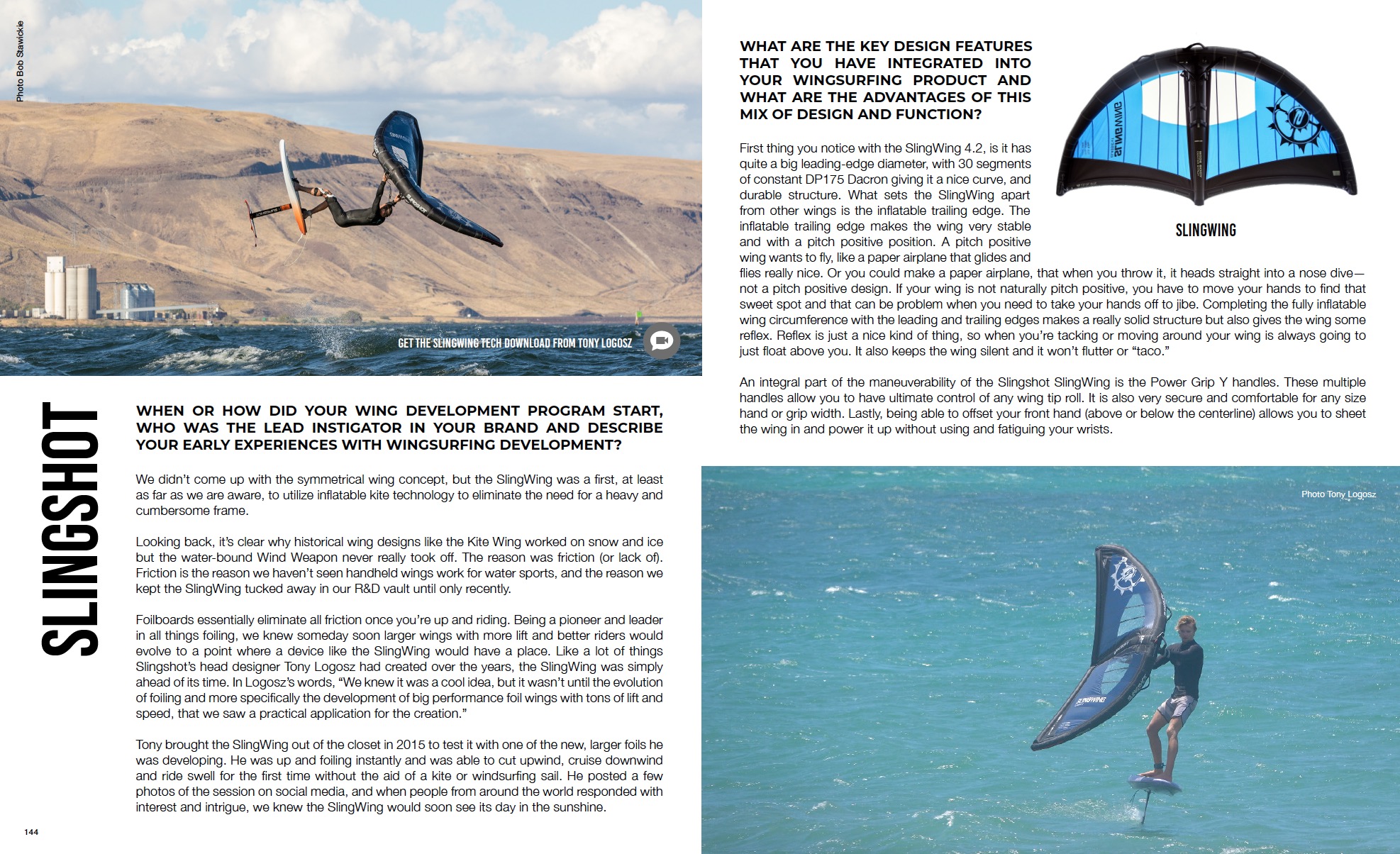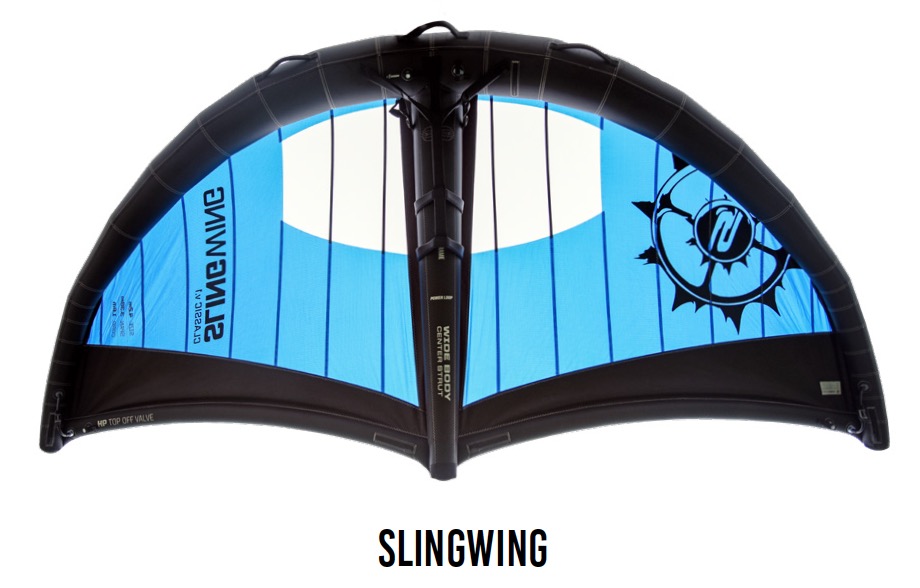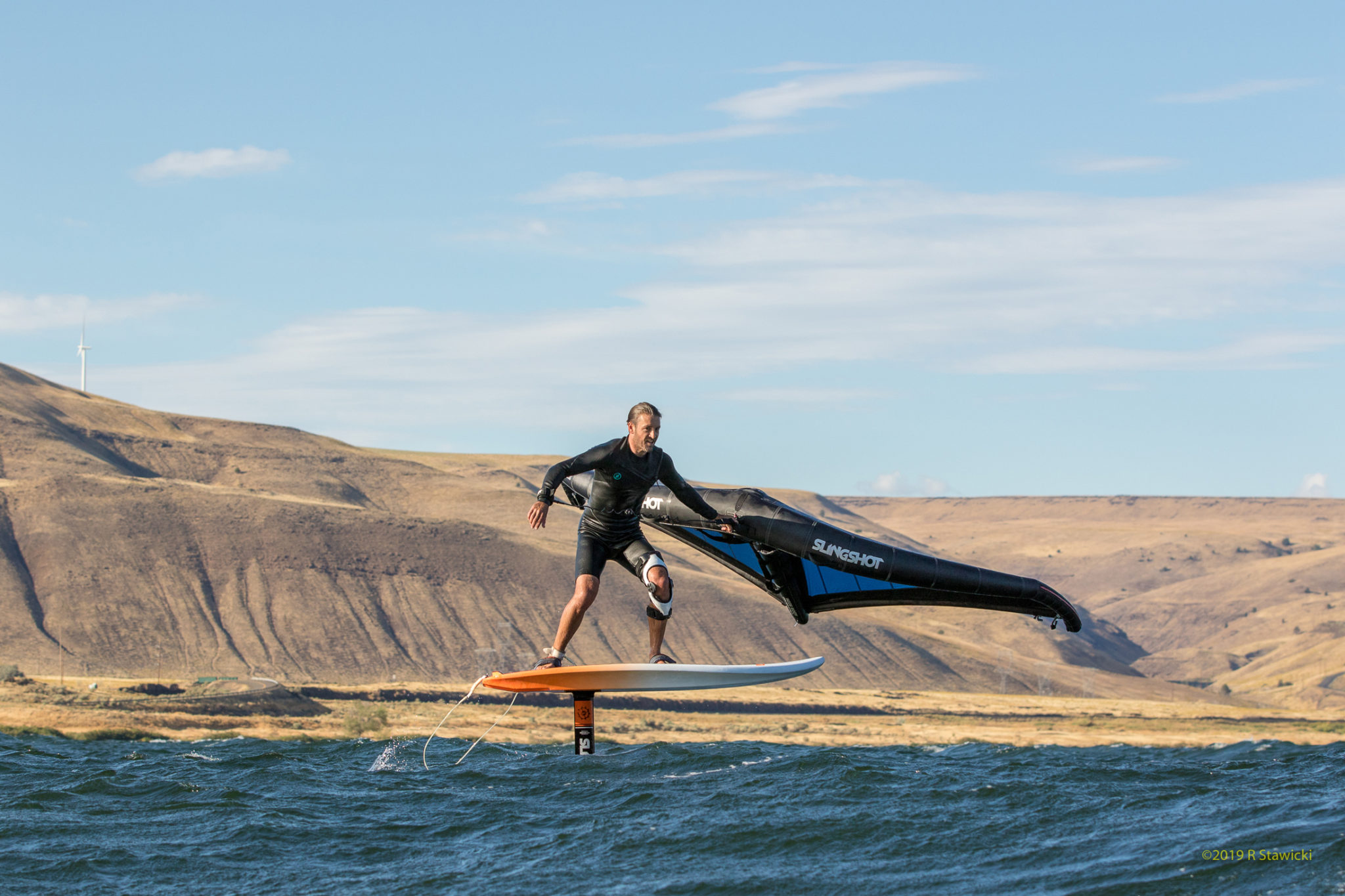 WHEN OR HOW DID YOUR WING DEVELOPMENT PROGRAM START, WHO WAS THE LEAD INSTIGATOR IN YOUR BRAND AND DESCRIBE YOUR EARLY EXPERIENCES WITH WINGSURFING DEVELOPMENT?
WHEN OR HOW DID YOUR WING DEVELOPMENT PROGRAM START, WHO WAS THE LEAD INSTIGATOR IN YOUR BRAND AND DESCRIBE YOUR EARLY EXPERIENCES WITH WINGSURFING DEVELOPMENT?
We didn’t come up with the symmetrical wing concept, but the SlingWing was a first, at least as far as we are aware, to utilize inflatable kite technology to eliminate the need for a heavy and cumbersome frame.
Looking back, it’s clear why historical wing designs like the Kite Wing worked on snow and ice but the water-bound Wind Weapon never really took off. The reason was friction (or lack of). Friction is the reason we haven’t seen handheld wings work for water sports, and the reason we kept the SlingWing tucked away in our R&D vault until only recently.
Foilboards essentially eliminate all friction once you’re up and riding. Being a pioneer and leader in all things foiling, we knew someday soon larger wings with more lift and better riders would evolve to a point where a device like the SlingWing would have a place. Like a lot of things Slingshot’s head designer Tony Logosz had created over the years, the SlingWing was simply ahead of its time. In Logosz’s words, “We knew it was a cool idea, but it wasn’t until the evolution of foiling and more specifically the development of big performance foil wings with tons of lift and speed, that we saw a practical application for the creation.â€
Tony brought the SlingWing out of the closet in 2015 to test it with one of the new, larger foils he was developing. He was up and foiling instantly and was able to cut upwind, cruise downwind and ride swell for the first time without the aid of a kite or windsurfing sail. He posted a few photos of the session on social media, and when people from around the world responded with interest and intrigue, we knew the SlingWing would soon see its day in the sunshine.
WHAT ARE THE KEY DESIGN FEATURESÂ THAT YOU HAVE INTEGRATED INTOÂ YOUR WINGSURFING PRODUCT ANDÂ WHAT ARE THE ADVANTAGES OF THISÂ MIX OF DESIGN AND FUNCTION?
First thing you notice with the SlingWing 4.2, is it has quite a big leading-edge diameter, with 30 segments of constant DP175 Dacron giving it a nice curve, and durable structure. What sets the SlingWing apart from other wings is the inflatable trailing edge. The inflatable trailing edge makes the wing very stable and with a pitch positive position. A pitch positive wing wants to fly, like a paper airplane that glides and flies really nice. Or you could make a paper airplane, that when you throw it, it heads straight into a nose dive— not a pitch positive design. If your wing is not naturally pitch positive, you have to move your hands to find that sweet spot and that can be problem when you need to take your hands off to jibe. Completing the fully inflatable wing circumference with the leading and trailing edges makes a really solid structure but also gives the wing some reflex. Reflex is just a nice kind of thing, so when you’re tacking or moving around your wing is always going to just float above you. It also keeps the wing silent and it won’t flutter or “taco.â€
An integral part of the maneuverability of the Slingshot SlingWing is the Power Grip Y handles. These multiple handles allow you to have ultimate control of any wing tip roll. It is also very secure and comfortable for any size hand or grip width. Lastly, being able to offset your front hand (above or below the centerline) allows you to sheet the wing in and power it up without using and fatiguing your wrists.
 HOW DOES YOUR DESIGN HANDLE THE STANDARD ASPECTS OF WINGSURFINGÂ PERFORMANCE: RELAUNCH, STABILITY, UPWIND ABILITY AND HOVER-ABILITY?
HOW DOES YOUR DESIGN HANDLE THE STANDARD ASPECTS OF WINGSURFINGÂ PERFORMANCE: RELAUNCH, STABILITY, UPWIND ABILITY AND HOVER-ABILITY?
The pitch positive design discussed earlier and the inflatable trailing edge help immensely with stability while hovering. When you are holding the Leading Edge Control Handle and depowering the wing to ride swell, the inflatable trailing edge keeps the trailing edge from fluttering uncontrollably and catching wind. The wide stiff Leading Edge Control handle allows you to actively control the wing while in hover position. The Power Grip Y Handles allow you to offset your front hand. This allows you to naturally power the wing up by holding the lower handle for speed and power. Holding the upper handle allows you to get more leverage and hang off the wing for insane upwind angles. Without the offset handles you would exhaust your wrists, rolling them to achieve the desired wing position. Slingshot’s Skate Scuff Tough Strips on the wingtips allowing you to use it on pavement or snow without immediately wearing through the strut and bladder. The Buddy Window help you avoid colliding with friends and provide ample downwind viewing. Lastly the one pump system allows you to pump up the Leading Edge, Split Strut and inflatable trailing edge all at once.
 WHAT APPROACH HAVE YOU TAKEN TO WING SIZING, AND HOW DO YOU RECOMMENDÂ THE VARIOUS SIZED WINGS TO YOUR POTENTIAL BUYERS?
WHAT APPROACH HAVE YOU TAKEN TO WING SIZING, AND HOW DO YOU RECOMMENDÂ THE VARIOUS SIZED WINGS TO YOUR POTENTIAL BUYERS?
Calling out the wind range of the wings is tough as it is completely dictated by your foil pumping ability and your weight. Our first release was the SlingWing 4.2 which really covers a wide wind range. Most folks can get going in about 16mph of wind, and due to the stability of the high-pressure inflatable trailing edge, you can still use it in 25+. You are really able to spill a lot of wind letting the wing fly high over your head, they don’t get overpowered easily. For most riders the 4.2 is an easy go-to decision. Our second release was the SlingWing 3.0 for smaller riders and winds over 25mph. Wings are ideal for kids so expect to see a 2.2 and even a 1.5 coming soon.
HOW DOES THE WING INTERMIX WITH YOUR CURRENT OFFERING OF FOIL WINGÂ AND FOILBOARD DESIGNS AND WHAT WILL BE YOUR FUTURE APPROACH TO BOARDÂ SIZING, VOLUME AND FEATURES?
The wide array of boards that are fun with the SlingWing has really blown us away. Our Outwit foil SUP line is the best pairing for sure; larger volumes make it easy, centerline straps are really helpful for control, and the track foil mount allow you to get the center of lift exactly where you want it. Every windfoil board in our line has proven to work exceptionally well even with the stock foil wings that come with the windfoil. The big volume and extra wide Levitator 160 is the easiest to learn on, and guys are ripping around on our smallest Windfoil Freestlyle 87L in the straps and loving it. For more advanced riders who can pull off a deep water start, the small, low volume kitefoil boards offer unparalleled maneuverability. The future in full radical design will definitely be tiny volume boards like the Dwarf Craft. For teaching non-wind people the future is in selling removable centerfins to allow people to stay upwind on their current large SUPs.
Watch Slingshot’s 2020 SlingWing Product Preview from AWSI
Tkb’s 2020 Wingsurf Buyer’s Guide is included within the pages of our 2020 Buyer’s Guide. Want more 2020 gear info? Get the latest product tech from all the top brands all in one convenient place.Â
